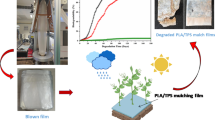Abstract
Synergic properties between starch and sugar were discovered. 100% crop-based starch and sugar formulations were studied. Classical preliminary tests such as curing temperature and gel time were measured for different starch-sucrose water suspensions. More significant information was deducted with applied tests such as plywood gluing tests and particleboard production. Wood-to-wood bonding properties were analysed applying NaOH and high temperature (180°C) as catalysts for starch gelification. Comparable strength to commercial urea-formaldehyde and polyvinyl acetate adhesives was achieved in plywood tests. Consequently, the knowledge acquired in wood bonding of flat surfaces was applied to particleboard production. These derived particleboards showed that it is possible to obtain a panel with only carbohydrates as gluing agent. Starch-sugar synergy in alkaline environment increases the internal bond (IB) of the natural panels up to 0.25 N/mm2. Possible mechanisms of synergy between these saccharides were proposed. Finally, a blended formulation with Mimosa tannin allows for achieving an internal bond of 0.40 N/mm2, which is the required value for interior grade particleboards (DIN EN 312). Starch-sugar-tannin adhesives are 100% environmentally-friendly formulations.
Zusammenfassung
Es wurden Synergieeffekte zwischen Stärke und Zucker in Klebstoffformulierungen entdeckt. Formulierungen mit 100 %iger natürlicher Stärke und Zucker wurden untersucht. Dabei wurden in klassischen Voruntersuchungen die Aushärtezeiten und Gelierzeiten von unterschiedlichen, wässrigen Stärke-Zucker-Formulierungen bestimmt. Aussagekräftige Ergebnisse zu mechanischen Festigkeiten wurden durch Verklebungsuntersuchungen mittels Sperrholzplatten und Herstellung von Spanplatten erzielt. Die Untersuchungen zur Klebefestigkeit im Quer-Zug-Versuch mittels Sperrholzplatten wurden nach dem Verpressen der Proben bei hohen Temperaturen (180°C) und unter Verwendung von Natronlauge als Katalysator für die Gelierung der Stärke durchgeführt. Die Untersuchungen mittels Sperrholzplattentests zeigten, dass vergleichbare Festigkeitswerte der Stärke-Zucker-Formulierungen zu handelsüblichen Polyurethan- und Polyvinylacetatklebstoffen erreicht werden konnten. Das Wissen aus den flächigen Verklebungen der Sperrholzplatten wurde für die Spanplattenerzeugung verwendet. Die entwickelten Klebstoffrezepturen zeigten die Möglichkeit auf, allein mittels Kohlenhydrat-Klebstoffen gebundene Spanplatten herzustellen. Stärke-Zucker-Synergien im alkalischen Bereich steigern die Querzugfestigkeit der kohlenhydratgebundenen Platten auf 0,25 N/mm2. Mögliche Mechanismen der Synergien zwischen diesen Sacchariden wurden ebenfalls beschrieben. Formulierungen mit Mimosa Tannin erbrachten eine Querzugsfestigkeit von 0,40 N/mm2, dies entspricht den Anforderungen der Norm (DIN EN 312) für Spanplatten für den Innenbereich. Stärke-Zucker-Tannin-Klebstoffe sind 100 %ige umweltfreundliche Formulierungen.








Similar content being viewed by others
References
Bock K, Lemieux RU (1982) The conformational properties of sucrose in aqueous solution: intramolecular hydrogen-bonding. Carbohydr Res 100(1):63–74
Bolivar AI, Venditti RA, Pawlak JJ, El-Tahlawy K (2007) Development and characterization of novel starch and alkyl ketene dimer microcellular foam particles. Carbohydr Polym 69:262–271
Cämmerer B, Wedzicha BL, Kroh LW (1999) Nonenzymatic browning reactions of retro-aldol degradation products of carbohydrates. Eur Food Res Technol 209:261–265
DIN EN 312 (2003) European Standard. 11-2003. Particleboards specifications. 1-21
Donovan JW (1979) Phase transition of the starch-water system. Biopolymers
Glenn GM, Miller RE, Irving DW (1996) Microcellular starch-based foams. ACS symposium series, vol 647, pp 88–106
Hansen LM, Setser CS, Paukstelis JV (1989) Investigations of sugar-starch interactions using carbon-13 nuclear magnetic resonance. Cereal Chem 66(5):411–415
Laufenberg TL (1986) Using gamma radiation to measure density gradients in reconstituted wood products. For Prod J 36(2):59–62
Lörcks J (1998) Properties and applications of compostable starch-based plastic material. Polym Degrad Stab 59(1–3):245–249
Moubarik A, Pizzi A, Ahmed A, Charrier F, Abdelouahed K, Charrier B (2010a) Cornstarch mimosa tannin–urea formaldehyde resins as adhesives in the particleboard production. Starch/Stärke 62(3–4):131–138
Moubarik A, Ahmed A, Pizzi A, Charrier F, Charrier B (2010b) Characterization of a formaldehyde-free cornstarch-tannin wood adhesive for interior plywood. Eur J Wood Prod 68:427–443
Pan Z, Cathcart A, Wang D (2006) Properties of particleboard bond with rice bran and polymeric methylene diphenyl diisocyanate adhesives. Ind Crops Prod 23:40–45
Pizzi A (1980) Tannin-based adhesives. Polym Rev 18(2):247–315
Queneau Y, Jarosz S, Lewandowski B, Fitremann J (2007) Sucrose chemistry and applications of sucrochemistry. Adv Carbanion Chem & Biochem 61:217–292
Radley J (1976) Industrial uses of starch and its derivatives. Appl Sci, Bracking, Chaps 1–2
Ragheb AA, El-Thalouth A, Tawfik S (1995) Gelatinization of starch in aqueous alkaline solutions. Strach/Stärke 47(9):338–345
Taher AM, Cates DM (1974) A spectrophotometric investigation of the yellow color that accompanies the formation of furan derivatives in degraded-sugar solutions. Carbohydr Res 34(2):249–261
Tester RF, Morrison WR (1990) Swelling and gelatinization of cereal starches. I. Effects of amylopectin, amylose, and lipids. Cereal Chem 67(6):551–557
Acknowledgements
We gratefully acknowledge the bachelor students Raphael Lampl, Martin Pavicsics, Christian Kolbitsch of the Forest Products Technology & Wood Construction and Mr. Hessenberger, HDEMC Hessenberger GmbH, for their ideas and contributions within the project. We further acknowledge the financial support of FWF Lise Meitner project M 1232-B16 and the FFG innovation check n. 824111.
Author information
Authors and Affiliations
Corresponding author
Rights and permissions
About this article
Cite this article
Tondi, G., Wieland, S., Wimmer, T. et al. Starch-sugar synergy in wood adhesion science: basic studies and particleboard production. Eur. J. Wood Prod. 70, 271–278 (2012). https://doi.org/10.1007/s00107-011-0553-z
Received:
Published:
Issue Date:
DOI: https://doi.org/10.1007/s00107-011-0553-z




